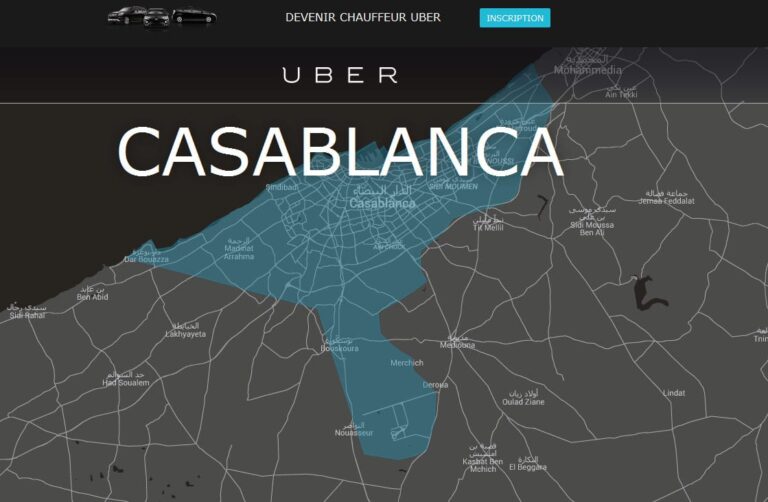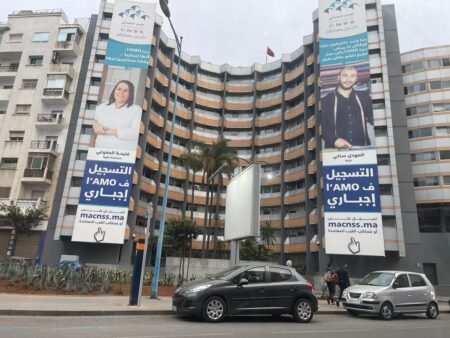The only positive thing to come out of Uber’s arrival in Morocco is recognition of the country’s economic development, with enough ‘potential’ to interest the specialist in impoverishment and the replacement of professionals by private individuals. But then again, we already had MacDo and Carrefour, and we’re about to get Ikea!
In reality, I think – and I could be wrong – that the arrival of Uber in Morocco is a future business case, as they say in business schools, but a textbook case of what people forget to take into account when setting up a business in an African country, particularly Morocco.
And as the subject of this blog is precisely how to work in Morocco, before giving you the four business ideas that can work, I wanted to show you, by example, what not to do.
Too long to read?
A hasty and ill-prepared opening could turn Uber’s move into Morocco into a failure. Could such rapid progress be linked to the international outcry against the American company? In any case, contrary to its claims, Uber is illegal in Morocco. A big additional risk for an offer that is too expensive and not adapted to local consumer habits.
And now it’s time to curl up in front of your PC and read!
Taxis in Morocco
In a strategic analysis, this is called an environmental study. If you know all this, you can skip straight to the second point, the arrival of Uber in Morocco.
For our readers who are not yet expatriates, taxis in Morocco are highly regulated. There is a separation between ‘small taxis‘ (urban) and ‘large taxis‘ (which can make road journeys), a colour code for each town, to prevent a taxi on a trip from going to its friends’ houses, a maximum mileage (impossible to cross Morocco with a small taxi or even a single large taxi), and a huge number of taxis, linked to the number of cars and the fact that taxis are shared.
It’s a bit surprising at first, but your taxi will jump around like a flea. Imagine, you’re at Porte d’Orléans, south of Paris, you’re on your way to Opéra, in the center, it’s going to stop, on Avenue du Général Leclerc, Avenue du Maine, and gradually pick up customers going in the same direction as you. It’s wonderfully organised, with customers being served in order of arrival (for example, I’m going to the Opéra, the next customer wants to go to Hermès on rue Saint Honoré, which is roughly on the same route, but there’s a diversion, so first I’m dropped off at the Opéra, then the taxi makes a short return trip to rue Saint Honoré), and everyone pays their fare. This keeps prices very low, and means that there are many more taxi ‘places’ than taxis.
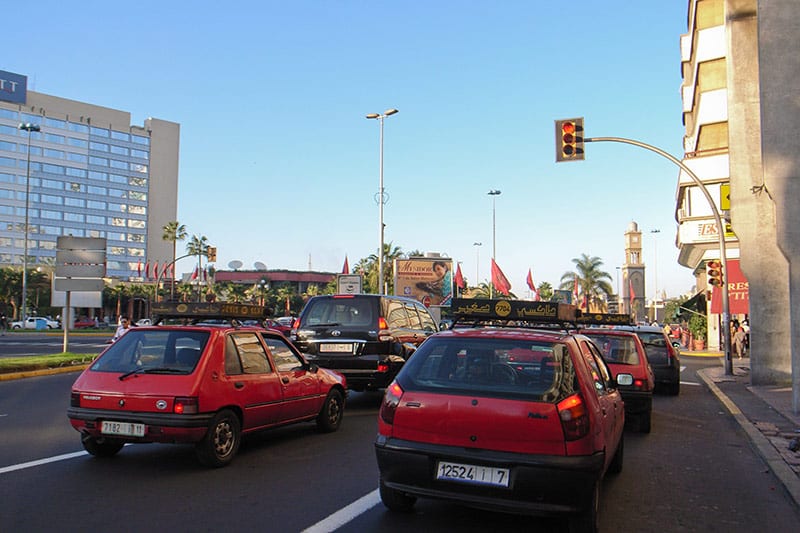
Most of the ‘small taxis’ are small, like Fiat Unos (and yes, you can fit 4 passengers in them), and some of them are pretty old, but the Moroccan government has launched a major programme to help modernise the taxi fleet, with trade-ins and financing. The big taxis are often old Mercedes, with improbable mileage, but which are still holding up. As they are “big” taxis, you can take up to six passengers, but you can also negotiate and pay the fare for several passengers so that you can leave straight away. They only load at stations reserved for them, whereas small taxis have stations everywhere (usually empty) and pick up passengers as they go.
Outside peak times, you can find a taxi wherever you want, for prices between €1 and €3. As you know, some taxis have a habit of forgetting the meter, so when you’re a tourist you’ll be taken for a ride at first. But it’s simple: you get into the taxi, if it doesn’t have a meter you give it the normal price, and if it complains, you threaten to call the police.
Tourist transportation
Finally, alongside the large and small taxis, there are the tourist transport vehicles which, as their name suggests, are there to transport tourists. These vehicles are subject to maximum restrictions, to avoid fraud and the work of “false guides” (tourist transporters are in the habit of acting like travel agencies and selling tours themselves, and official travel agencies are grumbling). Cars are therefore identified by a number plate, the driver’s name must appear in the logbook and he must have an official order from a principal.
And controls are real and frequent, as we shall see later.
Because in Morocco, tourists are sacred…
Taxis in Marrakesh
Tourists are sacred, except for Marrakesh taxis, which have a terrible reputation, even among Moroccans. Marrakshis taxis don’t negotiate, they rip off, they go round the medina three times through the palm grove instead of 50 metres, they charge 150 dirhams (€15) instead of 10, and they flatly refuse to take Moroccans, who know the prices.
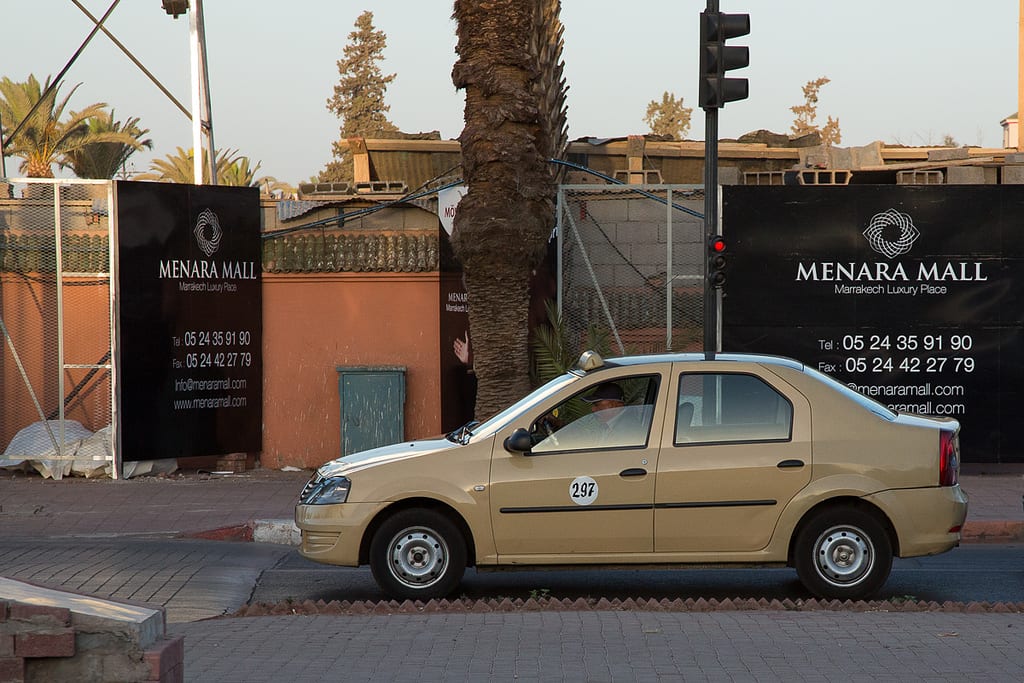
An international survey put them in last place, behind Mexican taxis.
In short, if you don’t like London taxis, take a taxi in Marrakesh…
So, just after Ramadan, Uber announces its arrival in Morocco
Here’s the article that came out yesterday in the Huffington Post Maghreb (French) on the arrival of Uber (you know, the Huffington Post, that pure player that wants nice free articles because it gets their authors publicity?).
It’s very interesting, because it seems to answer all the criticisms in advance, particularly those levelled at the two French Uber drivers.
Uber is not positioning itself as a competitor to taxis
Is that so? And to what? The tram? Private cars? Carrier pigeons? We have plenty of storks in Morocco, perhaps they carry adult passengers, not babies?
The target is (and I quote)
young professionals who have a smartphone and use their bankcards to pay online
In other words… not many people (payment for online purchases is not very widespread in Morocco, and this is one of the big difficulties for pure players like Kaymu or Jumia).
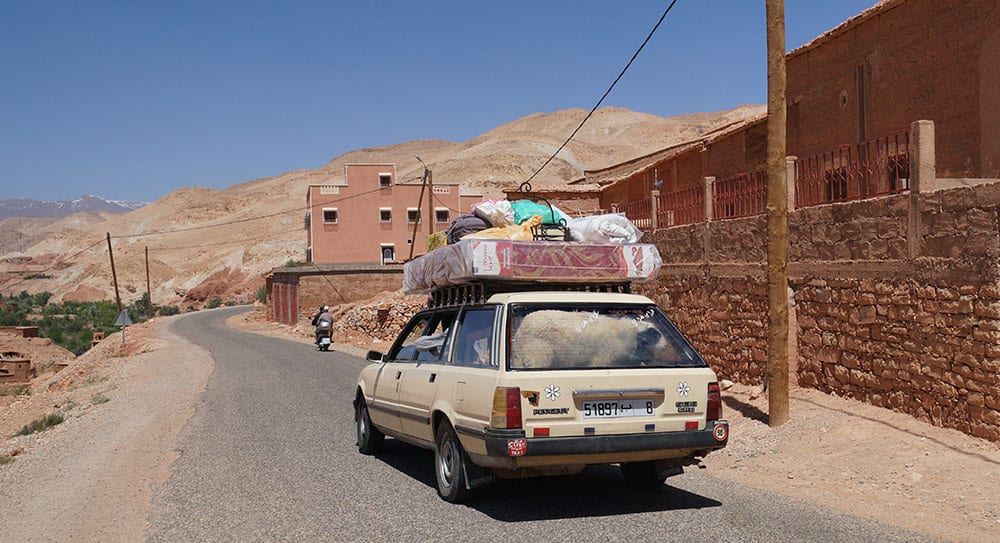
But there are two things to remember here:
- the target is either a car owner or a taxi user,
- the target is the Moroccan, not the tourist, i.e. the person who is not fooled by the closed meter.
A ‘premium but not luxury’ level, but one that’s expensive
This compares with a taxi fare of between 10 and 15 dirhams in Casa, and exceptionally for “long journeys” of up to 30 dirhams,
The basic fare is 20 dirhams, plus 5 dirhams per kilometre. The minimum fare is 30 dirhams.
So you pay at least the maximum price for a ride in Casa, just to have a recent car (there are more and more of them) and “to be able to choose your music“.
At 300% more on a fifteen-minute journey, frankly, music is a luxury I could do without!
And yet the Uber website has the nerve to write
The fare, which is generally lower than that of a taxi
Cancellation will be billed
To cancel an order, you will have to pay a similar amount.
So basically, if you’ve ordered, even if you have a problem, you pay…. Knowing Moroccans, that’s not going to work out well.
Uber promises to ensure passenger safety
That’s because of the harassment problems that Uber has experienced elsewhere, but it doesn’t make sense in the Moroccan context, particularly because taxis, while sometimes grumpy, are very attentive to the safety of their passengers.
How many times, when a woman goes home alone in the evening, does the taxi wait until she closes the door of her house before setting off again?
Payment is exclusively by credit card – and not just any credit card
We have signed partnerships with Attijari Wafabank, Banque Populaire and BMCE, whose classic cards work perfectly. The service is due to be extended to cardholders at other Moroccan banks. Cash payment is not out of the question, but it won’t be for a long time yet.
Admittedly, the three banks are among the largest in Morocco, but there are still a number missing.
Does it seem absurd to launch a service that not everyone can pay for?
Let me explain: in Morocco, bank cards are expensive for retailers. Especially for small transactions. These “partnerships” are therefore commercial negotiations to make the Uber service economically viable.
Certes, les trois banques sont parmi les plus importantes du Maroc, il en manque néanmoins un certain nombre à l’appel.
Is Uber legal? No, it isn’t!
A familiar refrain, until a country’s courts decide otherwise. What are the arguments?
Uber works in partnership with tourist transport companies. This gives us access to approved vehicles and experienced drivers. The private transport service will use 4*4 cross-over type vehicles because of the specifications of these companies.
I might as well tell you straight away, having reviewed the legislation on tourist transport companies, which I know quite well as it’s my husband’s old job :), I think that, contrary to Uber’s claims, the service is totally illegal in Morocco, absolutely outside the company’s object.
First of all, remember: this is aimed at young working people with a local bank card. They are not tourists.
I also really appreciate the fact that the use of 4x4s has been turned into an ‘advantage’, whereas it is, in my opinion, a major disadvantage.
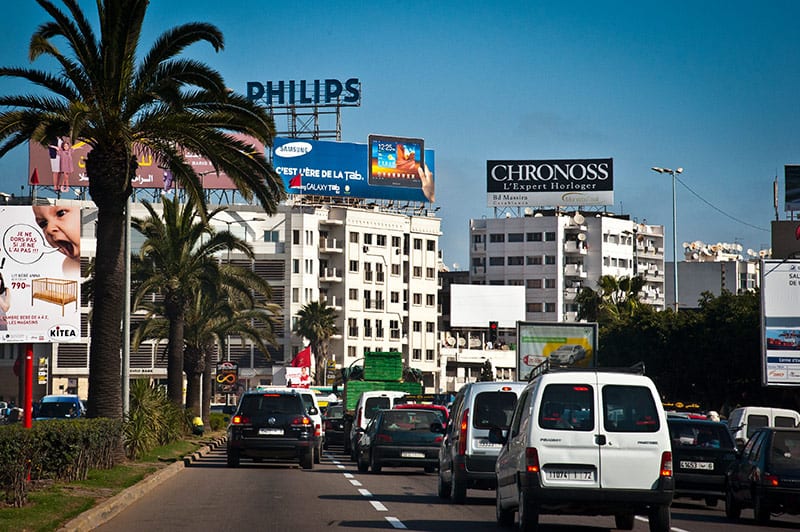
(Strengths and) weaknesses of Uber Morocco
Clearly, the price is a problem, it’s expensive, very expensive, and that’s normal, since we’re talking about 4x4s.
The fuel consumption of a 4×4 is almost double that of a normal car, and this at a time when the price of petrol is ‘less and less’ subsidised in Morocco.
The fact that you have to pay in advance, and pay a penalty if you abandon your order, is totally contrary to Moroccan usages. The craftsman tells you he’s coming, but he doesn’t turn up, so you make an appointment and put it off until tomorrow, an hour after you should have been there (when you say you’re not coming…).
The need is much lower than in Paris, London or New-York
It’s easy to get a taxi in Casa, outside rush hour. If you live in an area where taxis are rare, you’re either a rich Moroccan who already has two four-wheel drives and a Porsche, or a Moroccan who is not rich at all, who works for a rich Moroccan, and who takes the bus or the taxi, but for whom a difference of 20 dirhams represents two hours’ work.
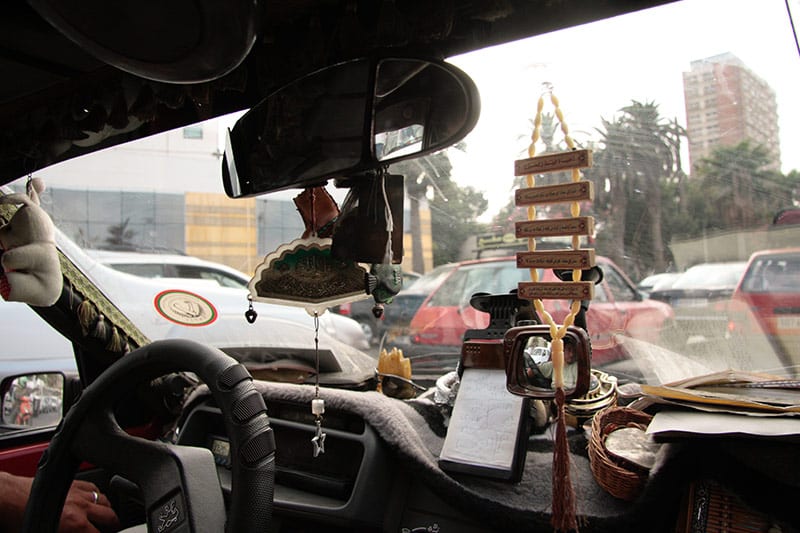
In rush hour, a 4×4 is at a terrible disadvantage.
Yes, Casablanca is a city where you can fit 4 cars and a scooter abreast on a two-lane road. Where incivility at the wheel takes on a whole new meaning. Where I refuse to get behind the wheel at those infamous rush hours, when I was whistling through the Place de la Concorde at 6.30pm on a Friday evening in record time, with my eyes almost shut.
A 4×4 is big, it doesn’t fit easily, it’s designed for the road and not for traffic jams, it wears out, it suffers, and it costs a lot more to repair if there’s a dent in the door.
Economically speaking, a 4×4 in a city taxi is a nonsense.
The impossibility of building customer loyalty
In Morocco, people are not “loyal” to a website. The “young professional” will be in no hurry to ask the driver for his telephone number, so that the next time he calls, he can order directly, avoiding Uber’s commission and paying in cash (I’m working on this very issue for another project).
Unlike the private individuals with whom Uber works in France, tourist transport companies know perfectly well how to manage bookings and schedules.
Uber is illegal
Repeating that we are within the law does not change the reality…
Several important points in the legislation on tourist transport vehicles are in total contradiction with the Uber practice as described.
Charging according to time spent and mileage is not authorised for large vehicles
The law clearly states that large delivery vehicles are not authorised to carry an odometer. In this case, Uber’s pricing system, as it appears on the website, is impossible:
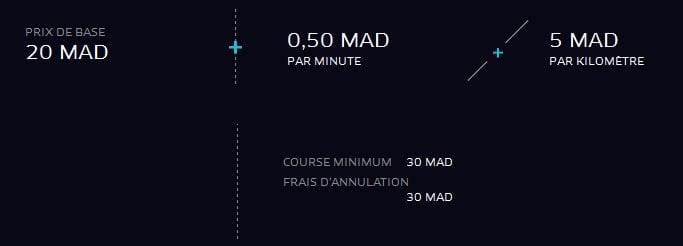
Of course, you could say that a GPS allows you to ‘do it’ and is not an odometer. But… it’s not sufficiently reliable either, and therefore not acceptable as a basis for invoicing.
We therefore conclude that Uber Maroc drivers cannot be TGRs (what’s more, a TGR is a saloon car, not a 4×4), and are therefore tourist transport vehicles.
The tourist carrier’s order form
In fact, it’s worse!
As I said, tourist transport is very strictly controlled, to prevent black-marketeers from stepping on the toes of other types of transport operator. Particularly when it comes to transporting residents, drivers must absolutely have the following items in their cars
an order form issued by a travel agency
or
A Passenger Manifest for resident tourists drawn up in accordance with Annex 3 of these specifications, sent before departure to the relevant departments of the Ministry of Public Works, Transport and Logistics, when transporting a group of resident tourists formed at the initiative of the group itself (as part of a non-profit-making activity for the organiser) or of an association or non-profit-making body.
The sample manifesto can be found in Appendix 3 (page 25) of the PDF. I’ve made a copy of it here, and in particular an extract from the problematic points (in French, sorry):
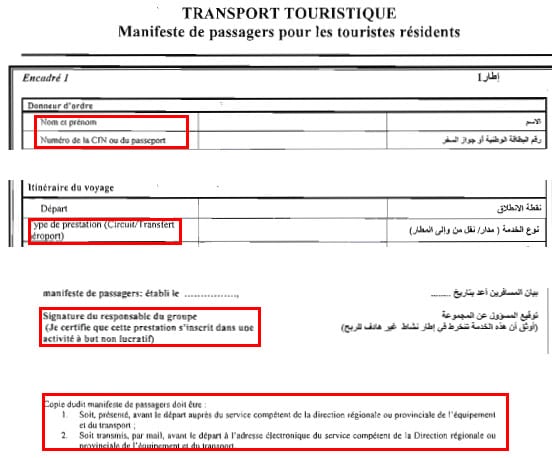
National identity card or passport number
In Morocco, the CIN number is an extremely precious item, which you don’t leave just anywhere. It identifies a person more reliably than a signature, in a country where half the adults are still illiterate, and it follows a person throughout their life (in other words, the new card will have the same number). I can’t see Uber customers agreeing to give out their CIN number via a smartphone app.
Tourist transport is not city transport
The manifest refers to a “tour” or “airport transfer”.
The PDF refers to “tourist road transport”.
In fact, the law specifies that:
Public passenger transport services are services offered to the public for commercial purposes for the carriage of passengers, with the exception of city services and taxis, which remain subject to regulations issued by local authorities.
In other words, a tourist transport vehicle is not allowed to make journeys in town other than as part of a tourist circuit organised by a travel agency or non-profit-making association.
The documents must be sent before the journey, signed.
With a signature. And no, in Morocco, a country where contracts are systematically legalised at police stations, an order placed via a smartphone app cannot be considered as a valid signature by a group manager.
Even if Uber manages to take care of the logistics of sending the order automatically and transferring and printing it in the tourist transport vehicle (why am I in any doubt here), this document will not have the signature and CIN card number required by law.
Unless Uber becomes the organiser?
Except that this is impossible, as Uber would de facto become an unauthorised travel agency.
(Opportunities) and threats
Self-cannibalisation by tourist transport companies
Both financially and legally, in the end, the only thing that Uber vehicles would be allowed to do is transfer passengers from the airport to the city centre.
Casablanca airport is 30 km away. It takes a minimum of 40 to 45 minutes.
The application of Uber pricing, in the wonderful world of Uber, gives us a price of around 200 dirhams. That’s less than the official fare (250 dirhams) charged to all taxis.
Except that…
- my calculation does not take into account the “empty ride” (the taxi drops off a customer, at a metered fare, and waits for one to return)
- tourist transport companies charge much more for this (between 500 dirhams and 750 dirhams)
To keep their promise (cheaper than taxis), Uber drivers would have to charge prices well below those that allow them to make a profit from their vehicles.
Let’s hope that the magic of the internet doesn’t allow tourist customers to find out and negotiate prices downwards.
Or they have to charge a high price for a service that already exists, by paying a commission to Uber. What the competition already offers on the internet, without commission.
Les concurrents justement
Uber has many competitors.
Contrary to what it says in its preamble, it attacks taxi drivers head-on, by proposing to allow tourist transport vehicles to make city trips.
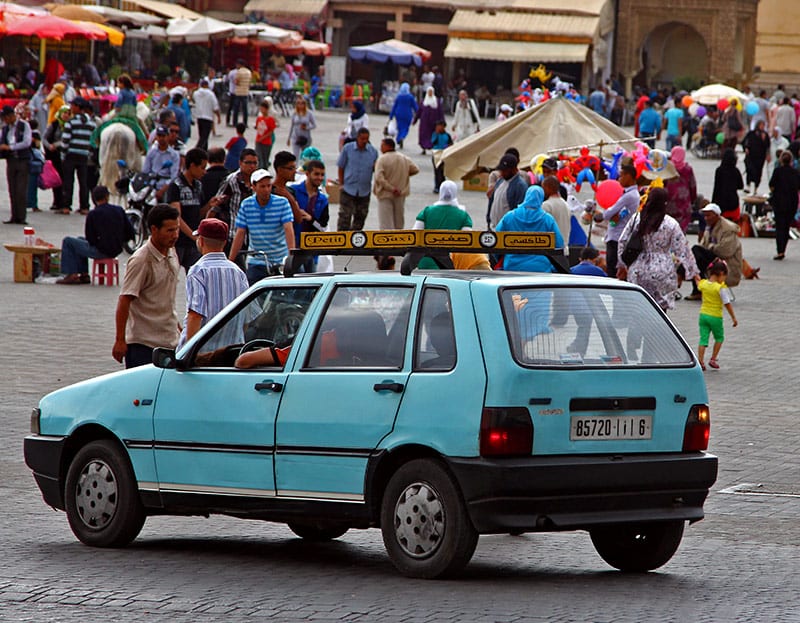
It is also taking on local websites that are starting up, such as votrechauffeur.ma or especially itaximaroc, which is very popular and local.
Finally, in the airport transfer market, it is also attacking hotels, which receive a commission from the drivers they send to pick up their customers when they charge for the service.
With reference to what is happening in France, I would remind you that in Morocco, when people get angry, they get violent. The lynching of the young man in Fez began with a simple dispute over an unpaid taxi fare…
Extension of the transport sector
For several years now, the government has been working on a difficult reform of the transport sector. The aim is to professionalise the sector, make it more secure without “killing off” the small businesses that are struggling to survive, provide a framework that gives them time to evolve, and make it more transparent ….
The hauliers’ federation is powerful. It has the capacity to bring the whole country to a standstill. During the latest negotiations, it obtained adjustments and concessions on everything except one thing: the extension of tourist transport to other types of service.
And that’s exactly what Uber is doing.
A failure to be expected?
To be honest, I don’t think Uber will be a success in Morocco. The pricing is too high, the target is too narrow, and the operating methods are not adapted to local customs.
Not least because if it were successful, the government would be obliged to block the company, as is gradually happening in all countries, even in Uber’s homeland.
In Morocco, the general practice is that “everything that is not authorised is forbidden“.
Admittedly, checks are not always very frequent, and fake taxis are allowed to survive in Casablanca, but when you want to… you block, and you even block violently.
Copying and pasting the idea into another context
This is one of the major sources of failure in Morocco, and it’s why I’ve talked about Uber here, and why I’ve taken the time to go into detail. It’s not enough to take on a ‘local manager’, especially in Morocco. You need someone who really knows the country. A lot of foreigners, especially the French, get bogged down trying to do things ‘like in France‘.
On paper, Uber Maroc is an interesting idea. But when you go into the details, you see that there are many negative aspects.
The LinkedIn CV of the director of Uber Maroc is the CV of a brilliant person, who has done very good studies, but who:
- studied and spent most of her career in France
- only returned to Morocco three years ago,
- is basically a consultant and financier (bank, Boston Consulting Group)
- has no experience or skills in the web or marketing fields
- only held managerial responsibilities for eleven months prior to this position
- only officially joined the Uber project in May.
The role of a Managing Director in a start-up (and Uber IS a start-up in the Moroccan context) is debatable. “Key co-ordinator’ or ‘core business person’? Personally, in the thirty years I’ve been working, I’ve seen a lot of companies brought down by high-level (or medium-level) consultants, and I think that the boss needs to have an in-depth knowledge of the business, as well as a coordinating role.
In this specific case, and solely on the basis of a public profile, we can ask ourselves some questions.
Marketing Bullshit
A final comment
Together, we’re boosting the local economy, limiting the number of drunk or distracted drivers on the roads and promoting a more connected, less congested world.
This is also on the Uber website. The only argument they could come up with was about fake taxis. All over the world, Uber is pitting “customers” against “taxis” when the majority of them are doing their job properly.
I prefer another quote:
It’s easy to make a splash in Morocco, but it’s hard to last there
When you have the idea of importing to Morocco something that works elsewhere, you first have to ask yourself the question
Why doesn’t this exist in Morocco?
Not because Moroccans are stupid, lack entrepreneurial spirit, etc… On the contrary. Moroccans are connected to the world, through the internet, through their curiosity, through their emigrant families.
More often than not, the answer is “because it can’t work like that“.
If you want to transpose a business concept here, be humble. Don’t come in as an inventor or a saviour – nobody was waiting for you, and the skills are there. Analyse and modify the concept sufficiently to give it every chance of success.
Edit: an update on the “new legislation”.
I’ve been criticised for basing myself on the old legislation. But…
- my sources are the official ones on Moroccan government websites
- the amendment dahirs relate to nationality conditions in 2006, dimensions and operating periods for different types of vehicle, on several occasions, most recently in 2014
- “the rest unchanged“.
It was the release of UberFiles in France that prompted me to re-read this post. How did the story end?
Uber finally left Morocco quickly
Barely 15 days after this post, the wilaya (prefecture) of Casablanca announced that Uber’s activity was illegal. Uber put forward the argument that “we’re just a platform”, and the wilaya (i.e. the Moroccan state) took Uber to court. Finally, at the beginning of 2018, Uber packed up and left, on the theme of “you’re all backward villains who don’t understand anything”.
Goodbye Uber, hello Careem
Careem, which carries out the same type of activities, has meanwhile set up in Morocco, where it is still operating.
Although Careem is a subsidiary of Uber, its business model is different, and responds to many of the criticisms I had when I was predicting Uber’s failure:
- inclusion of small taxis, which can take rides on the app
- the ability to pay in cash, not just by card (despite the widespread use of credit cards as a means of containment)
- different fare levels, so you don’t have to pay three arms for a bottle of water and some sweets…
 A typo or syntax error? You can select the text and hit Ctrl+Enter to send us a message. Thank you! If this post interested you, maybe you can also leave a comment. We'd love to exchange with you !
A typo or syntax error? You can select the text and hit Ctrl+Enter to send us a message. Thank you! If this post interested you, maybe you can also leave a comment. We'd love to exchange with you !

